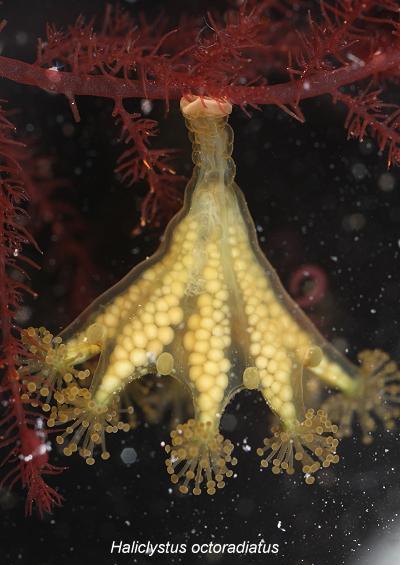STAUROMEDUSAE UK
An online guide to the Stalked jellyfish (Stauromedusae) found
around the coastal waters of the United Kingdom and Ireland.
Includes notes on their identification, and where and how to find them.
Species are collectively referred to as stauromedusae, from the animal order in which they belong. Stauromedusae is the only order within the class Staurozoa, which belongs to the Cnidaria.
The Cnidaria is divided into the subphyla Anthozoa and Medusozoa. In the UK the subphylum Anthozoa includes Sea anemones and Cold water corals, such as the Devonshire cup coral. The Medusozoa, including hydroids (Hydrozoa) and true jellyfish (Scyphozoa) and Stalked jellyfish (Staurozoa).
Classification: Biota > Animalia (Kingdom) > Cnidaria (Phylum) > Staurozoa (Class) > Stauromedusae (Order) >
From WoRMS (World Register of Marine Species)
Unlike true jellyfish, which are generally thought of as pelagic, drifting with ocean currents and sometimes wind, stalked jellyfish live on the shore and in the shallow waters around our coast, most attach to seaweed and Eelgrass from which they feed, but species like Depastrum cyathiforme attach to hard substrates such as rocks and boulders. A plate of this species has been added to the right for it appears there are no photographic records of this species.
On the shore, Stalked jellyfish occur from the middleshore to the low tide mark, and are most often found in rockpools, especially pools that drain into one another, and which contain a good range of algal species. Stalked jellyfish can also be found on algae out of water. Some species are seasonal, most are thought to have a single generation per year, although Craterolophus convolvulus has two generations per year.
In the UK some species are thought to be in decline, the reason or reasons for the decline are not very clear. Some species of stauromedusae appear to be quite photosensitive. This is purely conjecture, and a personal opinion, but if any decline is due to or partly due to photosensitivity, then cleaner coastal bathing water and longer periods of summer sunshine caused by a change in climate may have had and be having, a direct affect on them. These species may be found to be quite vulnerable to environmental and climatic change.
It appears that seawater of higher natural turbidity may be quite important in supporting good populations, e.g. in having particules that may filter or indeed reflect light. Particles may either be held in suspension, or held in the water column through constant agitation, e.g. that caused by wave or tides. Image to the right, shows two tubes; the tube on the right with a turbid sample of seawater, where particles are microscopic and held in suspension. The tube on the left has been agitated to show increased turbidity, such as caused by tides or waves. The fine particles seen are largely mineral and mainly quartz and mica from granite, so would both refract and to a degree reflect sunlight. Seawater that is naturally turbid may provide what is in effect a sun screen.
Turbity can be and has historically been, artificially increased by man, through pollution. It may just be a co-incidence that a decline in numbers of stauromedusae has been noticed most, during the years the sea has become cleaner around our coastline; especially in Devon and Cornwall, and potentially as a direct result of South West Water's Operation Cleansweep, and a changes in climate. As a result of decline, four species of Stalked jellyfish are UKBAP Priority Species, species of principal importance for the purpose of conservation of biodiversity under the Natural Environment and Rural Communities Act 2006. The four species are Haliclystus auricula (including H. octoradiatus), Calvadosia campanulata and Calvadosia cruxmelitensis.
Where they occur, or have been previously recorded, and at the right time of year, Stalked jellyfish are generally easy to find if one looks hard enough, in the right places. However, they often quite well camouflaged with the algae on which they occur, such as with red coloured specimens of Haliclystus octoradiatus on red algae, which may make finding them a good deal harder, or near impossible in poor weather conditions, when pools are murky, or in poor visibility.
